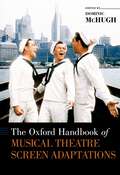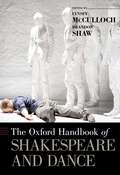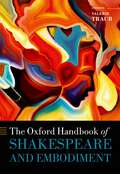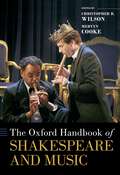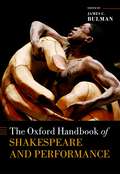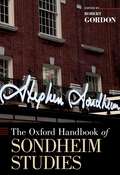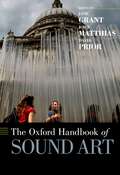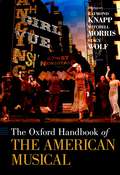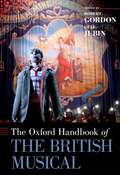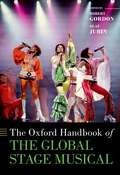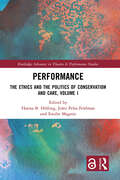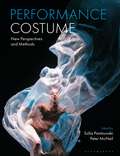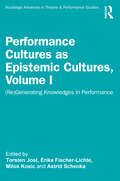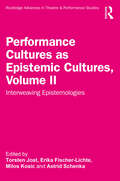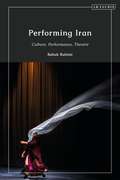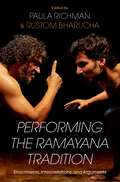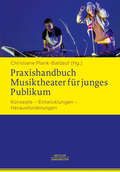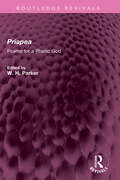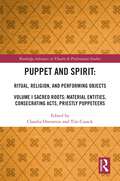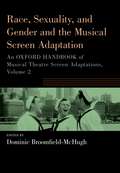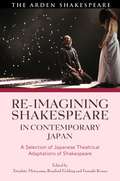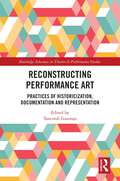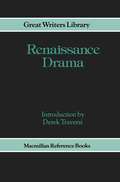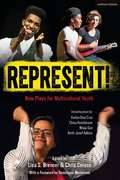- Table View
- List View
The Oxford Handbook of Musical Theatre Screen Adaptations (Oxford Handbooks)
Hollywood's conversion to sound in the 1920s created an early peak in the film musical, following the immense success of The Jazz Singer. The opportunity to synchronize moving pictures with a soundtrack suited the musical in particular, since the heightened experience of song and dance drew attention to the novelty of the technological development. Until the near-collapse of the genre in the 1960s, the film musical enjoyed around thirty years of development, as landmarks such as The Wizard of Oz, Meet Me in St Louis, Singin' in the Rain, and Gigi showed the exciting possibilities of putting musicals on the silver screen. The Oxford Handbook of Musical Theatre Screen Adaptations traces how the genre of the stage-to-screen musical has evolved, starting with screen adaptations of operettas such as The Desert Song and Rio Rita, and looks at how the Hollywood studios in the 1930s exploited the publication of sheet music as part of their income. Numerous chapters examine specific screen adaptations in depth, including not only favorites such as Annie and Kiss Me, Kate but also some of the lesser-known titles like Li'l Abner and Roberta and problematic adaptations such as Carousel and Paint Your Wagon. Together, the chapters incite lively debates about the process of adapting Broadway for the big screen and provide models for future studies.
The Oxford Handbook of Shakespeare and Dance (Oxford Handbooks)
Shakespeare's texts have a long and close relationship with many different types of dance, from dance forms referenced in the plays to adaptations across many genres today. With contributions from experienced and emerging scholars, this handbook provides a concise reference on dance as both an integral feature of sixteenth- and seventeenth-century culture and as a means of translating Shakespearean text into movement - a process that raises questions of authorship and authority, cross-cultural communication, semantics, embodiment, and the relationship between word and image. Motivated by growing interest in movement, materiality, and the body, The Oxford Handbook of Shakespeare and Dance is the first collection to examine the relationship between William Shakespeare - his life, works, and afterlife - and dance. In the handbook's first section - Shakespeare and Dance - authors consider dance within the context of early modern life and culture and investigate Shakespeare's use of dance forms within his writing. The latter half of the handbook - Shakespeare as Dance - explores the ways that choreographers have adapted Shakespeare's work. Chapters address everything from narrative ballet adaptations to dance in musicals, physical theater adaptations, and interpretations using non-Western dance forms such as Cambodian traditional dance or igal, an indigenous dance form from the southern Philippines. With a truly interdisciplinary approach, The Oxford Handbook of Shakespeare and Dance provides an indispensable resource for considerations of dance and corporeality on Shakespeare's stage and the early modern era.
The Oxford Handbook of Shakespeare and Embodiment: Gender, Sexuality, and Race (Oxford Handbooks)
The Oxford Handbook of Shakespeare and Embodiment brings together 40 of the most important scholars and intellectuals writing on the subject today. Extending the purview of feminist criticism, it offers an intersectional paradigm for considering representations of gender in the context of race, ethnicity, sexuality, disability, and religion. In addition to sophisticated textual analysis drawing on the methods of historicism, psychoanalysis, queer theory, and posthumanism, a team of international experts discuss Shakespeare's life, contemporary editing practices, and performance of his plays on stage, on screen, and in the classroom. This theoretically sophisticated yet elegantly written Handbook includes an editor's Introduction that provides a comprehensive overview of current debates.
The Oxford Handbook of Shakespeare and Music (Oxford Handbooks)
The Oxford Handbook of Shakespeare and Music showcases the latest international research into the captivating and vast subject of the many uses of music in relation to Shakespeare's plays and poems, extending from the Bard's own time to the present day. The coverage is truly global in its scope, with ground-breaking studies of Shakespeare-related music in countries as diverse as China, the Czech Republic, France, Germany, India, Italy, Japan, Russia, South Africa, Sweden, and the Soviet Union, as well as the Anglophone musical and theatrical traditions of the UK and USA. The range of genres surveyed is equally extensive, embracing music for theatre, opera, ballet, musicals, the concert hall, and film, in addition to Shakespeare's ongoing afterlives in folk music, jazz, and popular music. The authors take a range of diverse approaches in tackling their remits: some chapters investigate the evidence for performative practices in the Early Modern and later eras, while others offer detailed accounts of representative case studies, situating these firmly in their cultural contexts, or reflecting on the fascinating political and sociological ramifications of the music. As a whole, the Handbook provides a unique and impressively wide-ranging compendium of cutting-edge scholarship engaging with an extraordinarily rich body of music.
The Oxford Handbook of Shakespeare and Performance
The Oxford Handbooks to Shakespeare are designed to record past and present investigations and renewed and revised judgments by both familiar and younger Shakespeare specialists. Each of these volumes is edited by one or more internationally distinguished Shakespeareans; together, they comprehensively survey the entire field. Shakespearean performance criticism has firmly established itself as a discipline accessible to scholars and general readers alike. And just as performances of the plays expand audiences' understanding of how Shakespeare speaks to them, so performance criticism is continually shifting the contours of the discipline. The 36 contributions in this volume represent the most current approaches to Shakespeare in performance. They are divided into four parts. Part I explores how experimental modes of performance ensure Shakespeare's contemporaneity. Part II tackles the burgeoning field of reception: how and why audiences respond to performances as they do. Part III addresses the ways in which technology has revolutionized our access to Shakespeare, both through the mediums of film and sound recording and through digitalization. Part IV grapples with 'global' Shakespeare, considering matters of cultural appropriation in productions played for international audiences. Together, these ground-breaking essays attest to the richness and diversity of Shakespearean performance criticism as it is practiced today
The Oxford Handbook of Sondheim Studies (Oxford Handbooks)
The Oxford Handbook of Sondheim Studies offers a series of cutting-edge essays on the most important and compelling topics in the growing field of Sondheim Studies. Focusing on broad groups of issues relating to the music and the production of Sondheim works, rather than on biographical questions about the composer himself, the handbook represents a cross-disciplinary introduction to comprehending Sondheim in musicological, theatrical, and socio-cultural terms. This collection of never-before published essays addresses issues of artistic method and musico-dramaturgical form, while at the same time offering close readings of individual shows from a variety of analytical perspectives. The handbook is arranged into six broad sections: issues of intertextuality and authorship; Sondheim's pioneering work in developing the non-linear form of the concept musical; the production history of Sondheim's work; his writing for film and television; his exploitation and deployment of a wide range of musical genres; and how interpretation through key critical lenses (including sociology, history, and feminist and queer theory) establishes his position in a broader cultural context.
The Oxford Handbook of Sound Art (Oxford Handbooks)
Sound art has long been resistant to its own definition. Emerging from a liminal space between movements of thought and practice in the twentieth century, sound art has often been described in terms of the things that it is understood to have left behind: a space between music, fine art, and performance. The Oxford Handbook of Sound Art surveys the practices, politics, and emerging frameworks of thought that now define this previously amorphous area of study. Throughout the Handbook, artists and thinkers explore the uses of sound in contemporary arts practice. Imbued with global perspectives, chapters are organized in six overarching themes of Space, Time, Things, Fabric, Senses and Relationality. Each theme represents a key area of development in the visual arts and music during the second half of the twentieth century from which sound art emerged. By offering a set of thematic frameworks through which to understand these themes, this Handbook situates constellations of disparate thought and practice into recognized centers of activity.
The Oxford Handbook of The American Musical (Oxford Handbooks)
The Oxford Handbook of The American Musical offers new and cutting-edge essays on the most important and compelling issues and topics in the growing, interdisciplinary field of musical-theater and film-musical studies. Taking the form of a "keywords" book, it introduces readers to the concepts and terms that define the history of the musical as a genre and that offer ways to reflect on the specific creative choices that shape musicals and their performance on stage and screen. The handbook offers a cross-section of essays written by leading experts in the field, organized within broad conceptual groups, which together capture the breadth, direction, and tone of musicals studies today. Each essay traces the genealogy of the term or issue it addresses, including related issues and controversies, positions and problematizes those issues within larger bodies of scholarship, and provides specific examples drawn from shows and films. Essays both re-examine traditional topics and introduce underexplored areas. Reflecting the concerns of scholars and students alike, the authors emphasize critical and accessible perspectives, and supplement theory with concrete examples that may be accessed through links to the handbook's website. Taking into account issues of composition, performance, and reception, the book's contributors bring a wide range of practical and theoretical perspectives to bear on their considerations of one of America's most lively, enduring artistic traditions. The Oxford Handbook of The American Musical will engage all readers interested in the form, from students to scholars to fans and aficionados, as it analyses the complex relationships among the creators, performers, and audiences who sustain the genre.
The Oxford Handbook of the British Musical (Oxford Handbooks)
The Oxford Handbook of the British Musical provides a comprehensive academic survey of British musical theatre offering both a historical account of the musical's development from 1728 and a range of in-depth critical analyses of the unique forms and features of British musicals, which explore the aesthetic values and sociocultural meanings of a tradition that initially gave rise to the American musical and later challenged its modern pre-eminence. After a consideration of how John Gay's The Beggar's Opera (1728) created a prototype for eighteenth-century ballad opera, the book focuses on the use of song in early nineteenth century theatre, followed by a sociocultural analysis of the comic operas of Gilbert and Sullivan; it then examines Edwardian and interwar musical comedies and revues as well as the impact of Rodgers and Hammerstein on the West End, before analysing the new forms of the postwar British musical from The Boy Friend (1953) to Oliver! (1960). One section of the book examines the contributions of key twentieth century figures including Noel Coward, Ivor Novello, Tim Rice, Andrew Lloyd Webber, director Joan Littlewood and producer Cameron Macintosh, while a number of essays discuss both mainstream and alternative musicals of the 1960s and 1970s and the influence of the pop industry on the creation of concept recordings such as Jesus Christ Superstar (1970) and Les Misérables (1980). There is a consideration of "jukebox" musicals such as Mamma Mia! (1999), while essays on overtly political shows such as Billy Elliot (2005) are complemented by those on experimental musicals like Jerry Springer: the Opera (2003) and London Road (2011) and on the burgeoning of Black and Asian British musicals in both the West End and subsidized venues. The Oxford Handbook of the British Musical demonstrates not only the unique qualities of British musical theatre but also the vitality and variety of British musicals today.
The Oxford Handbook of the Global Stage Musical (Oxford Handbooks)
The stage musical constitutes a major industry not only in the US and the UK, but in many regions of the world. Over the last four decades many countries have developed their own musical theatre industries, not only by importing hit shows from Broadway and London but also by establishing or reviving local traditions of musical theatre. In response to the rapid growth of musical theatre as a global phenomenon, The Oxford Handbook of the Global Stage Musical presents new scholarly approaches to issues arising from these new international markets. The volume examines the stage musical from theoretical and empirical perspectives including concepts of globalization and consumer culture, performance and musicological analysis, historical and cultural studies, media studies, notions of interculturalism and hybridity, gender studies, and international politics. The thirty-three essays investigate major aspects of the global musical, such as the dominance of Western colonialism in its early production and dissemination, racism and sexism--both in representation and in the industry itself--as well as current conflicts between global and local interests in postmodern cultures. Featuring contributors from seventeen countries, the essays offer informed insider perspectives that reflect the diversity of the subject and offer in-depth examinations of specific cultural and economic systems. Together, they conduct penetrating comparative analysis of musical theatre in different contexts as well as a survey of the transcultural spread of musicals.
Performance: The Ethics and the Politics of Conservation and Care, Volume I (Routledge Advances in Theatre & Performance Studies)
This book focuses on performance and performance-based artworks as seenthrough the lens of conservation, which has long been overlooked in the largertheoretical debates about whether and how performance remains. Unraveling the complexities involved in the conservation of performance,Performance: The Ethics and the Politics of Conservation and Care (vol. 1)brings this new understanding to bear in examining performance as an object ofstudy, experience, acquisition, and care. In so doing, it presents both theoreticalframeworks and functional paradigms for thinking about—and enacting—theconservation of performance. Further, while the conservation of performance isundertheorized, performance is nevertheless increasingly entering the artmarket and the museum, meaning that there is an urgent need for discourse onhow to care for these works long-term. In recent years, a few pioneering conservators,curators, and scholars have begun to create frameworks for the longtermcare of performance. This volume presents, explicates, and contextualizestheir work so that a larger discourse can commence. It will thus serve the needsof conservation students and professors, for whom literature on this subject issorely needed. This interdisciplinary book thus implements a novel rethinking of performancethat will challenge and revitalize its conception in many fields, such as art history,theater, performance studies, heritage studies, and anthropology.
Performance Costume: New Perspectives and Methods
Costume is an active agent for performance-making; it is a material object that embodies ideas shaped through collaborative creative work. A new focus in recent years on research in the area of costume has connected this practice in vital and new ways with theories of the body and embodiment, design practices, artistic and other forms of collaboration. Costume, like fashion and dress, is now viewed as an area of dynamic social significance and not simply as passive reflector of a pre-conceived social state or practice. This book offers new approaches to the study of costume, as well as fresh insights into the better-understood frames of historical, theoretical, practice-based and archival research into costume for performance.This anthology draws on the experience of a global group of established researchers as well as emerging voices. Below is a list of just some of the things it achieves:1. Introduces diverse perspectives, innovative new research methods and approaches for researching design and the costumed body in performance.2. Contributes towards a new understanding of how costume actually 'performs' in time and space.3. Offers new insights into existing practices, as well as creating a space of connection between practitioners and researchers from design, the humanities and social sciences.
Performance Cultures as Epistemic Cultures, Volume I: (Re)Generating Knowledges in Performance (Routledge Advances in Theatre & Performance Studies)
This volume investigates performances as situated "machineries of knowing" (Karin Knorr Cetina), exploring them as relational processes for, in and with which performers as well as spectators actively (re)generate diverse practices of knowing, knowledges and epistemologies. Performance cultures are distinct but interconnected environments of knowledge practice. Their characteristic features depend not least on historical as well as contemporary practices and processes of interweaving performance cultures. The book presents case studies from diverse locations around the globe, including Argentina, Canada, China, Greece, India, Poland, Singapore, and the United States. Authored by leading scholars in theater, performance and dance studies, its chapters probe not only what kinds of knowledges are (re)generated in performances, for example cultural, social, aesthetic and/or spiritual knowledges; the contributions investigate also how performers and spectators practice knowing (and not-knowing) in performances, paying particular attention to practices and processes of interweaving performance cultures and the ways in which they contribute to shaping performances as dynamic "machineries of knowing" today. Ideal for researchers, students and practitioners of theater, performance and dance, (Re)Generating Knowledges in Performance explores vital knowledge-serving functions of performance, investigating and emphasizing in particular the impact and potential of practices and processes of interweaving of performance cultures that enable performers and spectators to (re)generate crucial knowledges in increasingly diverse ways.
Performance Cultures as Epistemic Cultures, Volume II: Interweaving Epistemologies (Routledge Advances in Theatre & Performance Studies)
This volume investigates performance cultures as rich and dynamic environments of knowledge practice through which distinctive epistemologies are continuously (re)generated, cultivated and celebrated. Epistemologies are dynamic formations of rules, tools and procedures not only for understanding but also for doing knowledges. This volume deals in particular with epistemological challenges posed by practices and processes of interweaving performance cultures. These challenges arise in artistic and academic contexts because of hierarchies between epistemologies. European colonialism worked determinedly, violently and often with devastating effects on instituting and sustaining a hegemony of modern Euro-American rules of knowing in many parts of the world. Therefore, Interweaving Epistemologies critically interrogates the (im)possibilities of interweaving epistemologies in artistic and academic contexts today. Writing from diverse geographical locations and knowledge cultures, the book’s contributors—philosophers and political scientists as well as practitioners and scholars of theater, performance and dance—investigate prevailing forms of epistemic ignorance and violence. They introduce key concepts and theories that enable critique of unequal power relations between epistemologies. Moreover, contributions explore historical cases of interweaving epistemologies and examine innovative present-day methods of working across and through epistemological divides in nonhegemonic, sustainable, creative and critical ways. Ideal for practitioners, students and researchers of theater, performance and dance, Interweaving Epistemologies emphasizes the urgent need to acknowledge, study and promote epistemological plurality and diversity in practices of performance-making as well as in scholarship on theater and performance around the globe today.
Performing Iran: Culture, Performance, Theatre
The result of collaborative research from noteworthy dramatists and scholars, this volume investigates the dynamic relationship between culture, performance and theatre in Iran. The studies gathered here examine how various forms of performances, especially theatre, have and continue to undergo change in response to shifting political and social settings from the antiquity to the present day. The analysis in this book focuses on performance practices, examining drama, texts, rituals, plays, music, cinema and drama technologies. This is done in order to show how Iran has been imagined through enactments and representations, and reproduced through these performative actions. The book uses a wider definition of the concept of 'performance', offering analysis of a wide range of phenomena, including indigenous rituals – such as the naqqali and taziyeh – and online performances by diaspora communities.
Performing the Ramayana Tradition: Enactments, Interpretations, and Arguments
The Ramayana, one of the two pre-eminent Hindu epics, has played a foundational role in many aspects of India's arts and social norms. For centuries, people learned this narrative by watching, listening, and participating in enactments of it. Although the Ramayana's first extant telling in Sanskrit dates back to ancient times, the story has continued to be retold and rethought through the centuries in many of India's regional languages, such as Hindi, Tamil, and Bengali. The narrative has provided the basis for enactments of its episodes in recitation, musical renditions, dance, and avant-garde performances. This volume introduces non-specialists to the Ramayana's major themes and complexities, as well as to the highly nuanced terms in Indian languages used to represent theater and performance. Two introductions orient readers to the history of Ramayana texts by Tulsidas, Valmiki, Kamban, Sankaradeva, and others, as well as to the dramaturgy and aesthetics of their enactments. The contributed essays provide context-specific analyses of diverse Ramayana performance traditions and the narratives from which they draw. The essays are clustered around the shared themes of the politics of caste and gender; the representation of the anti-hero; contemporary re-interpretations of traditional narratives; and the presence of Ramayana discourse in daily life.
The Plays of Maura Laverty: Liffey Lane, Tolka Row, A Tree in the Crescent
Published here for the first time, Maura Laverty’s plays Liffey Lane, Tolka Row and A Tree in the Crescent are rooted in 1950s Dublin, its territories and enclaves. Teeming with the lives of the poor, the ambitious, the trapped and the struggling, the plays are moving, funny and vividly alive. They capture the capital in a state of transformation – reaching for modernisation while still enmired in stagnant class divisions, poor housing and narrow social values. Key to all three plays are questions of home, the lives of women and girls, and the impact of conservative government policies and church attitudes. Already a public figure in Irish life, and an influencer before her time through her fiction, cookery books and broadcasting, Laverty’s plays met with huge success when staged in 1951 and 1952 by Hilton Edwards of the Gate Theatre Company at Dublin’s Gaiety and Gate Theatres and on tour. Laverty’s trilogy is a significant and long-awaited part of the twentieth-century Irish theatrical canon. This volume presents the Trilogy, including a preface by Christopher Fitz-Simon, who knew and worked with Laverty. The editors’ introduction contextualises Laverty’s work and considers the theatrical values of the plays.
Praxishandbuch Musiktheater für junges Publikum: Konzepte – Entwicklungen – Herausforderungen
Zeitgenössisches Musiktheater für junges Publikum hat sich weit über den deutschsprachigen Raum hinaus zu einem wichtigen Genre im aktuellen Theaterbetrieb entwickelt. Dieses Handbuch gibt aus theaterpraktischer, künstlerischer und wissenschaftlicher Perspektive einen Überblick über die verschiedenen Arbeits- und Themenfelder. Ausgehend von der Vielfalt musikdramatischer Erscheinungsformen werden kompositorische und konzeptionelle Entstehungs- und Produktionsbedingungen untersucht, Wechselwirkungen zwischen strukturellen und ästhetischen Erscheinungsformen überprüft, Möglichkeiten interdisziplinärer und interkultureller Arbeitsweisen skizziert sowie Wege der Vermittlungsarbeit aufgezeigt. Das Handbuch vermittelt auf diese Weise nicht nur breite Einblicke in die aktuelle Diskussion der Zielsetzungen, Anforderungen und Wahrnehmungsweisen, sondern liefert auch vielfältige Anregungen.
Priapea: Poems for a Phallic God (Routledge Revivals)
First published in 1988, Priapea is a collection of eighty Latin epigrams, English translated, that make up the corpus Priapeorum, which displays remarkable skill, artistry and wit. Their elegance of style contrasts strikingly with their indecent subject matter. The poems are mostly spoken by, or addressed to, the lewd god Priapus, famous for the size and tenseness of his erect membrum virile or phallus. A main theme is the threatened use of his formidable organ to assault obscenely any intruders that he may catch thieving, but requests and offsprings made to Priapus, and his comparison of himself with other deities, also figure prominently among the poems. This book will be of interest of literature, classical studies, and translation studies.
Puppet and Spirit: Volume I Sacred Roots: Material Entities, Consecrating Acts, Priestly Puppeteers (Routledge Advances in Theatre & Performance Studies)
This anthology of essays aims to explore the many types of relationships that exist between puppets, broadly speaking, and the immaterial world. The allure of the puppet goes beyond its material presence as, historically and throughout the globe, many uses of puppets and related objects have expressed and capitalized on their posited connections to other realms or ability to serve as vessels or conduits for immaterial presence. The flip side of the puppet’s troubling uncanniness is precisely the possibilities it represents for connecting to discarnate realities. Where do we see such connections? How do we describe, analyze, and theorize these relationships? The first of two volumes, this book focuses on these questions in relation to long-established, traditional practices using puppets, devotional objects, and related items with sacred aspects to them or that perform ritual roles. Looking at performance traditions and artifacts from China, Indonesia, Korea, Mali, Brazil, Iran, Germany, and elsewhere, the essays from scholars and practitioners provide a range of useful models and critical vocabularies for addressing the ritual and spiritual aspects of puppet performance, further expanding the growing understanding and appreciation of puppetry generally. This book, along with its companion volume, offers, for the first time, robust coverage of this subject from a diversity of voices, examples, and perspectives.
Race, Sexuality, and Gender and the Musical Screen Adaptation: An Oxford Handbook of Musical Theatre Screen Adaptations, Volume 2 (OXFORD HANDBOOKS SERIES)
Hollywood's conversion to sound in the 1920s created an early peak in the film musical, following the immense success of The Jazz Singer. The opportunity to synchronize moving pictures with a soundtrack suited the musical in particular, since the heightened experience of song and dance drew attention to the novelty of the technological development. Until the near-collapse of the genre in the 1960s, the film musical enjoyed around thirty years of development, as landmarks such as The Wizard of Oz, Meet Me in St. Louis, Singin' in the Rain, and Gigi showed the exciting possibilities of putting musicals on the silver screen. The second of three volumes, Race, Sexuality, and Gender and the Musical Screen Adaptation: An Oxford Handbook, traces how the genre of the stage-to-screen musical has evolved, focusing in particular of issues of race, gender and sexuality. Enduringly popular adaptations such as Kiss Me Kate and Pal Joey are considered through the lens of identity, while several chapters consider how different adaptations of the same stage musical reflect shifting historical contexts. Together, the chapters incite lively debates about the process of adapting Broadway for the big screen and provide models for future studies. Volume I: The Politics of the Musical Theatre Screen Adaptation Volume II: Race, Sexuality, and Gender and the Musical Screen Adaptation Volume III: Stars, Studios, and the Musical Theatre Screen Adaptation
Re-imagining Shakespeare in Contemporary Japan: A Selection of Japanese Theatrical Adaptations of Shakespeare
An anthology of three exciting Japanese adaptations of Shakespeare that engage with issues such as changing family values, racial diversity, the 2011 Great East Japan Earthquake and terrorism, together with a contextualizing introduction.The anthology makes contemporary Japanese adaptations of Shakespeare by three independent theatre companies available to a wider English language audience. The three texts are concerned with the social issues Japan faces today and Japan's perception of its cultural history. This unique collection is thus both a valuable resource for the fields of Shakespeare and adaptation studies as well as for a better understanding of contemporary Japanese theatre.
Reconstructing Performance Art: Practices of Historicisation, Documentation and Representation (Routledge Advances in Theatre & Performance Studies)
This book investigates the practices of reconstructing and representing performance art and their power to shape this art form and our understanding of it. Performance art emerged internationally between the 1960s and 1970s crossing disciplinary boundaries between performing arts and visual arts. Because of the challenge it posed to the ontologies and paradigms of these fields, performance art has since stimulated an ongoing debate on the most appropriate means to document, preserve and display it. Tancredi Gusman brings together international scholars from different disciplinary fields to examine methods, media, and approaches by which this art form has been represented and (re)activated over time and its transnational history reconstructed. Through contributions and case studies spanning various countries, regions and artistic fields, the authors outline an innovative theoretical-methodological framework for capturing the processes and strategies for transmitting the tangible and intangible heritage of performance art. This book will be of great appeal to students, researchers, and practitioners in the fields of Theatre and Performance Studies as well as Visual Arts and Art History, who have an interest in performance art, its history and presence in the contemporary artistic and cultural landscape.
Represent!: New Plays for Multicultural Young People (Plays for Young People)
In their exposé of Gen Z, The New York Times qualified its members as the “most diverse generation in American history". Recent Broadway hits have found a successful formula in productions showcasing the emotional turmoil of contemporary young people, yet the majority of these works represent predominantly white voices, both in terms of authorship and representation. Non-white characters tend to exist only in a world of colorblind casting rather than speaking to their distinct racial and cultural heritage.This anthology helps correct that balance and presents a unique offering of plays written for multicultural teenagers by diverse authors who have spent a significant part of their careers working closely with young people in urban settings. The playwrights - among them award winners such as Chisa Hutchinson and Nilaja Sun - have created texts that are dramatic and comic, satirical and earnest, touchingly real, and amusingly surreal. Varying in length and format, suitable for classrooms and youth groups of all sizes, the plays address such themes as ethnic and cultural identity; ancestry and assimilation; bullying and self-empowerment; disenfranchisement and alienation; parental pressure to over-achieve, youth activism and community-building; and the very real perils of daily school life in an era of gun proliferation.
